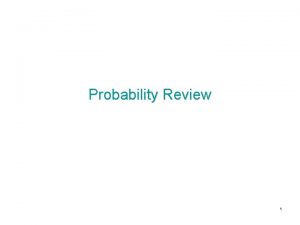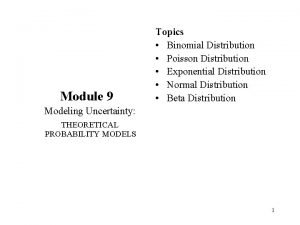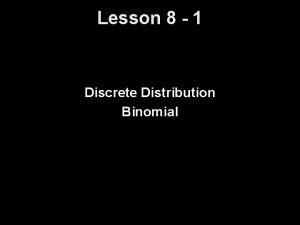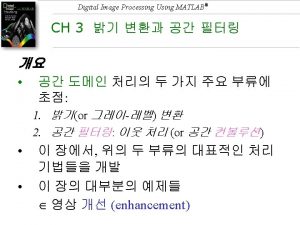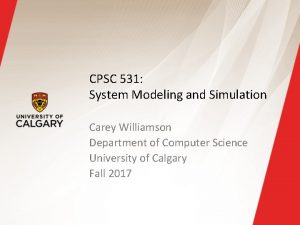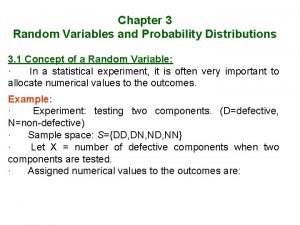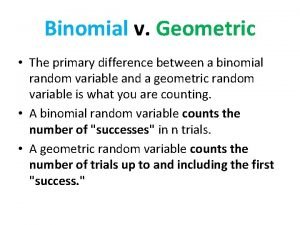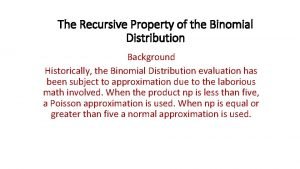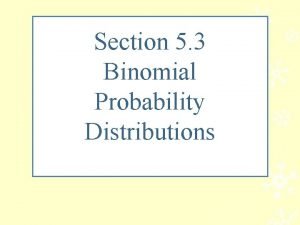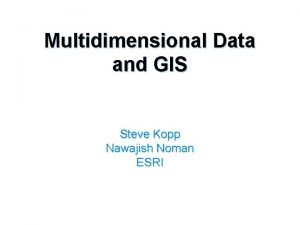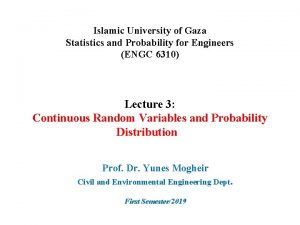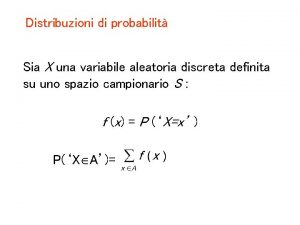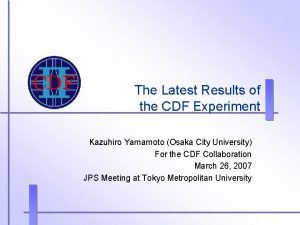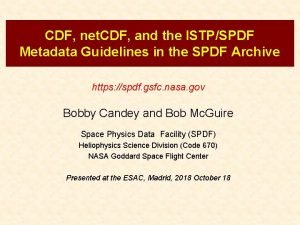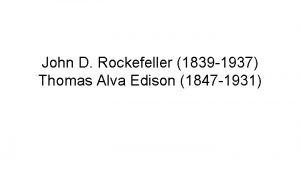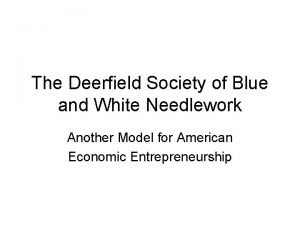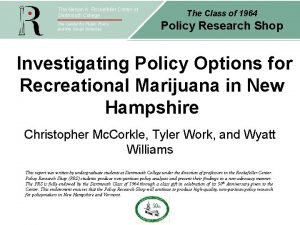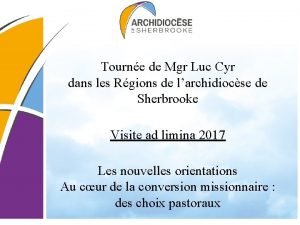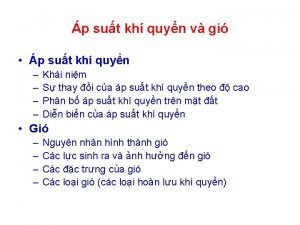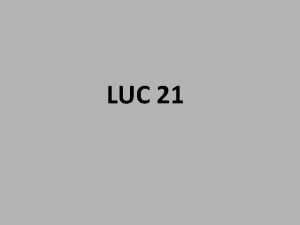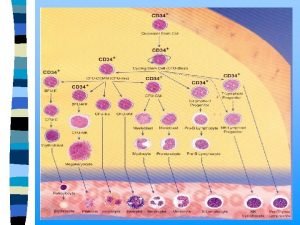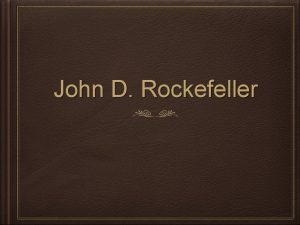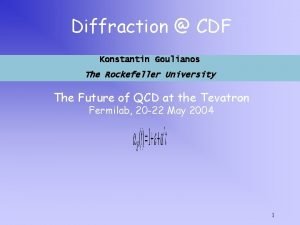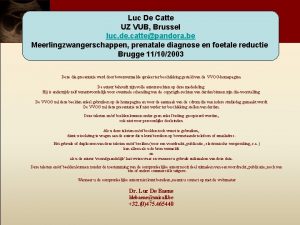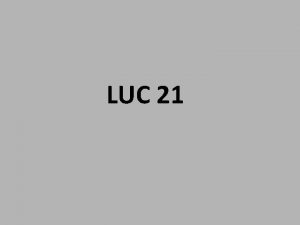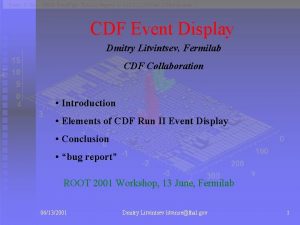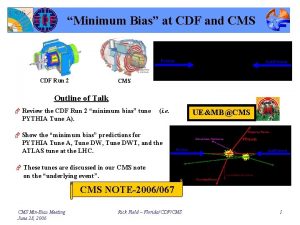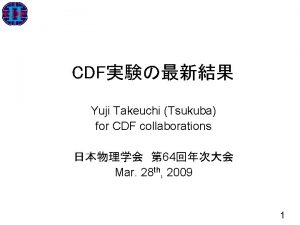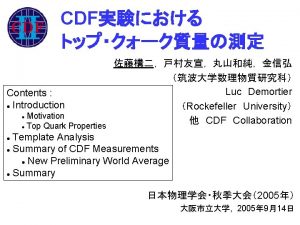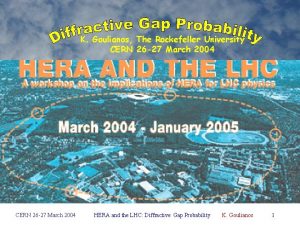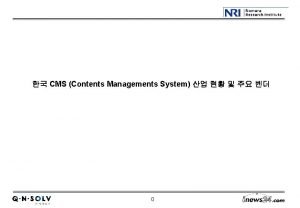CDF Luc Demortier Contents l Introduction Rockefeller University









































- Slides: 41

CDF実験における トップ・クォーク質量の測定 佐藤構二, 戸村友宣, 丸山和純, 金信弘 (筑波大学数理物質研究科) Luc Demortier Contents : l Introduction (Rockefeller University) Motivation 他 CDF Collaboration Top Quark Properties l Template Analysis l Summary of CDF Measurements l New Preliminary World Average l Summary l l 日本物理学会・秋季大会(2005年) 大阪市立大学, 2005年 9月14日

Tevatron Run II since Summer 2001 p – p collisions at s = 1. 96 Te. V (1. 8 Te. V in Run I). 32 cm-2 s-1. l Peak luminosity record : 1. 4 x 10 -1 of collisions in Run II. l Tevatron has already delivered 1. 2 fb -1 of data. l CDF has acquired ~1 fb -1 of data. l Analysis in this presentation uses 318 pb l l Direct study on top quark is only possible at Tevatron!

Collider Detector at Fermilab Multi-purpose detector Tracking in magnetic field. Ø Tracking coverage |h|<~1. Ø Magnetic field = 1. 4 T. l Precision tracking with silicon. Ø 7 layers of silicon detectors. l EM and Hadron Calorimeters. Ø s /E ~ 14%/ E (EM). E Ø s /E ~ 84%/ E (HAD). E l Muon chambers. l

Top Quark Mass - Introduction • Top is one of the least well studied elementary particles (evidence by CDF in 1994 / discovery by CDF/D 0 in 1995). • Top mass is a fundamental parameter of the Standard Model. • Mass measurements of top and W constrain the Higgs mass. W t W H b W l l Tevatron Run I average : mtop = 178. 0 2. 7 3. 0 Ge. V/c 2 mhiggs 260 Ge. V/c 2 (95% C. L. ) CDF Run II goal : Dmtop ~ 2 Ge. V/c 2 l mtop EWSB scale. Special role of top?

Top Quark Production and Decay l l We use pair creation events (s~6 pb-1) to measure mtop. Top decays before hadronization. ttop=0. 4 x 10 -24 s < 1/LQCD 10 -23 s. Br(t Wb) 100%. b g 15% g q 85% q 100% l+ t W+ n q t 100% Wq’ b Final states : We measure top mass in l+jets channel. Mode Br. (%) dilepton 5% Clean but few signal. Two n’s in final state. lepton+jets 30% One n in final state. Manageable bkgd. all hadronic 44% Large background. t+X 21% t-ID is challenging.

Flow of Mass Measurement 1 isolated e or m w/ PT>20 Ge. V, |h|<~1 Missing ET >20 Ge. V 4 jets (Jet. Clu w/ DR=0. 4) B-tagging of jets. l l Event-by-event top mass Parameterize distribution as a function of true top mass. l Collision data c 2 Fitter Bkgd. MC Event Selection Signal MC Template Fit (Likelihood Fit) l Look for top mass and background fraction that describes the data distribution best.

B-Tagging Algorithms • SECVTX – Reconstructs secondary vertex of B-hadron decay. – Tags b-jets by displacement of secondary vertex from primary vertex. • Jet Probability (JP) – Looks at the impact parameters of tracks in the jet and calculates probability of the jet to originate from the primary vertex. – Tags b-jet according to the calculated probability. – We have optimized JP algorithm for the best sensitivity to top mass. eb elight flavor SECVTX 28% 0. 34% JP 33% 4. 1% JP has looser tagging condition with larger b-tagging efficiency.

Subsample Categorization 4 jets in final state 12 parton-to-jet assignments. g B-tagging information helps in correct reconstruction of signal events! g Uncertainty minimum in double tagged candidates. Use of JP doubles the double tagging efficiency! Category 2 -tag (S+S) 2 -tag 1 -tag(T) (S+J) b l+ q t t q n W+ q Wb 1 -tag(L) 0 -tag j 1 -j 3 ET>15 ET>21 j 4 ET>8 ET>15 15>ET>8 ET>21 b-tag condition 2 SECVTX # parton-jet Assignment 2 2 6 6 12 S/N (318 pb-1) 17/1 15/1 36/7 11/10 ~20/20 1 SECVTX + 1 JP q’ 0 SECVTX 2 -tag samples are much purer and easier to reconstruct!

Extracting Top Mass for each Candidate Event Minimize c 2 to reconstruct event-by-event top mass (2 -C fit). Fluctuate particle momenta according to detector resolution. Mtop as free param. Constrain masses of 2 W’s. l t and t have the same mass. 2 jets from W decay + 2 b-jets. 12 jet-parton assignments. Assignment inconsistent with b-tagging information is rejected. 2 ØWe choose the assignment with smallest c as seemingly correct event reconstruction. We reject events with c 2>9, as seemingly background. Ø l

Top Mass Templates Mtop distribution shape is parameterized as a function of true top mass using ttbar Monte Carlo samples with different top mass assumptions. Signal Template (1 tag. T) Background distribution is also fit into a function, but NOT dependent of top mass. Background Template (1 tag. T) Mtop (Ge. V/c 2)

Result of Fit to Data Likelihood fit looks for top mass that describes the data Mtop distribution best (template fit). l l The background fraction is constrained by estimation for tagged samples. The background fraction is free in 0 tag sample. 2 tag (S+J) Mtop (Ge. V/c 2) 2 tag (S+S) Mtop (Ge. V/c 2) 1 tag. T Mtop (Ge. V/c 2) 1 tag. L 0 tag L = 318 pb-1 Mtop (Ge. V/c 2) mtop = 173. 0 +2. 9/-2. 8 (stat) 3. 3 (syst) Ge. V/c 2 Jet Energy Scale (JES) Uncertainty = 3. 0 Ge. V/c 2

Improved Fitting • In-situ JES calibration w/ W jj invariant mass in g q candidate events. • (Mtop, W invariant mass) are parametrized as functions of (true top mass, JES). q g • Likelihood fit is performed in (true top mass, JES) plane (2 -D fit). • Currently only using SECVTX tagger. • Further improvement can be achieved by optimizing b-tagging conditions. b l+ t t n W+ q Wb q’ top mass (Ge. V/c 2) Even better than Run I World Ave! L = 318 pb-1 mtop = 173. 5 +2. 7/-2. 6 (stat) 3. 0 (syst) Ge. V/c 2 JES syst = 2. 5 compared to 3. 0 wo/ in situ calibration

Future Projection Total uncertainty of 2 -D fit measurement will achieve Dmtop 2 Ge. V/c 2 in the end of CDF Run II. l Conservative projection assuming only stat. and JES will improve. l We can improve other syst. uncertainties. l We will optimize btagging condition for 2 -D fit in the next round. Currently it only uses SECVTX. We will do better! l Aimed for luminosity of Tevatron Run II.

Summary of Run II Measurements CDF Run II Top Mass Measurements Preliminary World Average with CDF/D 0, Run I/Run II Measurements Only best analysis from each decay mode, each experiment.

Updated Electroweak Fit w/ Preliminary CDF + D 0, Run I + Run II Combined : mtop=172. 7 2. 9 Ge. V/c 2 mhiggs=91 +45/-32 Ge. V/c 2 mhiggs 186 Ge. V/c 2 (95% CL) w/ Tevatron Run I average : 178. 0 4. 3 Ge. V/c 2 : mhiggs=114 +69/-45 Ge. V/c 2, mhiggs 260 Ge. V/c 2 (95% CL)

Summary • CDF L+Jets Template w/ JP : mtop=173. 0 +4. 4/-4. 3 Ge. V/c 2 (318 pb-1). • Template fit with in-situ JES calibration is the best single measurement and better than Run I World Average : mtop=173. 5 +4. 1/-4. 0 Ge. V/c 2 (318 pb-1). This analysis will achieve Dmtop ~ 2 Ge. V/c 2 in the end of Run II. • Preliminary combination of CDF and D 0 (Run. I + Run II): mtop=172. 7 2. 9 Ge. V/c 2. (Run I World Average : 178. 0 4. 3 Ge. V/c 2) mhiggs=91 +45/-32 Ge. V/c 2, mhiggs 186 Ge. V/c 2 (95% CL). (mhiggs 260 Ge. V/c 2 using Run I World Average) l Next Winter with 1 fb-1 dataset ( 3 statistics). - Improvement of dominant uncertainties by 1/ L. - D 0 Run II Dilepton and All Hadronic channel from CDF/D 0 Run II will be newly included in combined measurement. - We expect a good improvement in precision of measurement again!

Backup

Results of Template Measurements Template + JP Template + JES Summer 2004 176. 7+6. 0 -5. 4 7. 1 177. 2+4. 9 -4. 7 6. 6 Summer 2005 173. 2+2. 9 -2. 8 3. 4 173. 0+2. 9 -2. 8 3. 3 173. 5+2. 7 -2. 6 3. 0

CDF L+jets Template Group Intstitutes : Tronto 3 UC Berkeley 2 Chicago 4 JINR 2 Fermilab 1 Pisa 1 Tsukuba 4 Rockefeller 1 • Template Method measurement was reported by – Fermilab Today "CDF Tops the Top World Average“ (April 21, 2005) – KEK News "質量起源の解明をめざして" (May 19, 2005)

Event Selection • One isolated high PT lepton (e/m). – e : ET > 20 Ge. V, |h|<1. 1, shower shape, matching between calorimeter cluster and track. – m : PT > 20 Ge. V, |h|<1. 0, matching between muon chamber hits and track, energy deposit in calorimeter. • Missing ET > 20 Ge. V, to ensure there was a n in the final state. • 4 Jets reconstructed using JETCLU algorithm with cone size 0. 4. Sample subdivision by b-tagging conditions. – 1 and 2 tag channels : • More than 3 jets with ET >15 Ge. V, |h|<2. 0. • The 4 th jet with ET >8 Ge. V, |h|<2. 0. – 0 tag channel : • 4 jets with ET >21 Ge. V, |h|<2. 0. • We only consider the leading 4 jets as products of ttbar decay, when 5 jets are found in a event. • Two b-tagging algorithms – SECVTX and Jet Probability.

Jet Probability Algorithm (1)

Jet Probability Algorithm (2)

Uncertainty on Jet Energy Measurement

Jet Energy Uncertainty Compared with Run I

Optimization of Jet Probability • Jet Probability algorithm calculates probability of the jet to originate from the primary vertex. • We apply a cut on the calculated probability for b -tagging. • We optimized the cut value for the best statistical sensitivity to top quark mass in a Monte Carlo study. Statistical error minimum for top mass measurement!

Expected Number of Events Comparison of number of events between data and expectation : m to p = 17 5 G m to p e. V / c 2 =1 78 G e. V /c 2

Fraction of Correctly Reconstructed Events In ttbar MC events with mtop=178 Ge. V/c 2. 47% 40% 25% 15% 20%

Fraction of Correctly Reconstructed Events In ttbar MC events with mtop=178 Ge. V/c 2. Categorization with SECVTX only. 47% 28% 18% 20%

Definition of Likelihood

Result of Fit to Data Likelihood fit looks for top mass that describes the data Mtop distribution best (template fit). l l The background fraction is constrained by estimation for tagged samples. The background fraction is free in 0 tag sample. 2 tag (S+J) Mtop (Ge. V/c 2) 2 tag (S+S) Mtop (Ge. V/c 2) 1 tag. T Mtop (Ge. V/c 2) L = 318 pb-1 1 tag. L Mtop (Ge. V/c 2) 0 tag Mtop (Ge. V/c 2)

Measured Top Mass Breakdown of Systematic Errors -ln(L/Lmax) Likelihood vs mtop Top mass (Ge. V/c 2) Jet Energy Scale (JES) is dominant! L = 318 pb-1 mtop = 173. 0 +2. 9/-2. 8 (stat) 3. 3 (syst) Ge. V/c 2

Cross Check • The obtained statistical uncertainty is consistent with expectation from Monte Carlo study.

Improved Fitting Method • Syst. Uncertainty = 3. 3 Ge. V/c 2 is dominated by JES uncertainty ( 3. 0 Ge. V/c 2 ). • Most JES uncertainties are shared between light flavor and b-jets. Only 0. 6 Ge. V/c 2 additional uncertainty on mtop due to b-jet specific systematics. Likelihood fit with constraint on the dijet mass in candidate events. b g g q q l+ t W+ n q t Wq’ b Use dijet invariant mass for in-situ JES calibration.

Templates with JES (Mtop, hadronic W invariant mass) are parametrized as functions of (true top mass, JES). Event-by-event Mtop is also largely dependent on JES. Mtop distribution is now parameterized as a function of true top mass mtop and JES. l Hadronic W mass Template JES shifted by – 3 s, -1 s, … of generic jet calibration mjj varies significantly as a function of JES. l

Result of 2 -D Fit (with only SECVTX) Likelihood fit looks for top mass, JES and background fraction that describes the data Mtop and mjj distributions best. Mtop distributions : L = 318 pb-1 2 tag Mtop (Ge. V/c 2) 1 tag. T Mtop (Ge. V/c 2) 1 tag. L Mtop (Ge. V/c 2) 0 tag Mtop (Ge. V/c 2) Top mass (Ge. V/c 2) mtop = 173. 5 +3. 7/-3. 6 (stat+JES) 1. 7 (syst) Ge. V/c 2 mtop = 173. 5 +2. 7/-2. 6 (stat) 3. 0 (syst) Ge. V/c 2 Even better than Run I World Ave! JES syst 2. 5 compared to 3. 1 wo/ in situ calibration

Future Projection l Total uncertainty of 2 -D fit measurement will be Dmtop 2 Ge. V/c 2 in the end of CDF Run II. Conservative projection assuming only stat. and JES will improve. l We can improve other syst. uncertainties. l We will optimize b-tagging condition for 2 -D fit. Currently it only uses SECVTX. We will do better! l Aimed for luminosity of Tevatron Run II.

Summary of Run II Measurements

Run II Combined Top Mass Only best analysis from each decay mode, each experiment. Correlation : l uncorrelated stat. Ø fit method Ø in situ JES Ø 100% w/i exp (same period) l Ø JES due to calorimeter 100% w/i channel l Ø bkgd. model 100% w/i all l JES due to fragmentation, Ø signal model Ø MC generator Ø

New Preliminary World Average Combination of the best analysis from each decay mode, each experiment. Correlation : Split into 2 to isolate “in situ” JES systematics from other JES mtop=172. 7 1. 7 (stat) 2. 4 (syst) Ge. V/c 2

Future Improvements l Combined Result: Ge. V/c 2 Result l 172. 7 Stat. 1. 7 JES 2. 0 Sig. Model 0. 9 Bkgd. Model 0. 9 Multi-Interaction 0. 3 Fit Method 0. 3 MC Generator 0. 2 Total Syst. 2. 4 Total Error 2. 9 l l l Syst. already dominates the uncertainty! Basic improvement by 1/ L - L 1 fb-1 in next Winter. - In-situ JES calibration is a powerful tool. It can be introduced to other L+jets analyses. Sig. /Bkgd. Modeling (ISR/FSR/Q 2 dependence etc. ) can be improved by using our own data. D 0 Run II Dilepton measurement is coming soon. Measurements in All Hadronic mode (CDF/D 0) are under development.

Zbb Trigger : • 2 SVT track + 2 10 Ge. V clusters. Offline Cuts : • N==2 jets w/ ET>20 Ge. V, |h|<1. 5 (Jet. Clu cone 0. 7). • Both jets are required to have secondary vertex tag. l Df(j 1, j 2)>3. 0. • ET 3 rd-jet<10 Ge. V.
 Tevatron cdf
Tevatron cdf Cdf vs pdf
Cdf vs pdf Application of binomial distribution
Application of binomial distribution How to use binomial cdf
How to use binomial cdf Cdf esa
Cdf esa Matlab cdf 그리기
Matlab cdf 그리기 Cdf for uniform distribution
Cdf for uniform distribution Cdf definition
Cdf definition Difference between binomial and geometric random variable
Difference between binomial and geometric random variable Cdf-s xt1
Cdf-s xt1 Binomial cdf
Binomial cdf Binom cdf
Binom cdf Gridded data
Gridded data Cdf of an exponential distribution
Cdf of an exponential distribution Cdf certification
Cdf certification Cdf variabile aleatoria
Cdf variabile aleatoria Cdf
Cdf Cat in image processing
Cat in image processing Cdf net
Cdf net Contents introduction
Contents introduction Carnegie horizontal integration
Carnegie horizontal integration John d. rockefeller iii
John d. rockefeller iii Professional development program, rockefeller college
Professional development program, rockefeller college Alva rockefeller
Alva rockefeller John d. rockefeller iii
John d. rockefeller iii Oldest rockefeller alive
Oldest rockefeller alive Carnegie and rockefeller venn diagram
Carnegie and rockefeller venn diagram Andy woods daniel
Andy woods daniel Rockefeller center gingerbread house
Rockefeller center gingerbread house Red china johnnie ray
Red china johnnie ray Horizontal integration rockefeller
Horizontal integration rockefeller Rockefeller center dartmouth
Rockefeller center dartmouth Luc zoom
Luc zoom Mgr luc cyr
Mgr luc cyr Jean-luc mélenchon jeanine bayona
Jean-luc mélenchon jeanine bayona Cấu tạo lục lạp
Cấu tạo lục lạp Lực coriolis
Lực coriolis Luc hulsman
Luc hulsman Luc 21
Luc 21 Luč si za svet
Luč si za svet Komórki peroksydazo ujemne luc
Komórki peroksydazo ujemne luc Công thức tính độ biến thiên đông lượng
Công thức tính độ biến thiên đông lượng

